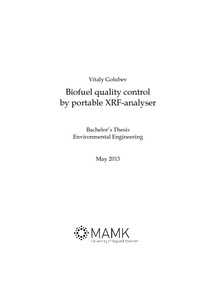Biofuel quality control by portable XRF-analyser
Golubev, Vitaly (2015)
Golubev, Vitaly
Mikkelin ammattikorkeakoulu
2015
All rights reserved
Julkaisun pysyvä osoite on
https://urn.fi/URN:NBN:fi:amk-201505219446
https://urn.fi/URN:NBN:fi:amk-201505219446
Tiivistelmä
The objective of this thesis project was to find out feasibility of using a handheld XRF-analyser in solid biofuel quality control, particularly for recovered wood. Global biomass supply is estimated to grow rapidly, creating demand for automatic quality control systems. X-ray fluorescent technology brings about quick, accurate and non-destructive elemental analysis. Recovered wood fuel is challenging for combustion due to high levels of contaminants. During this work a list of challenging chemical elements in recovered wood fuel was created after reviewing relevant EU standards.
XRF technology has its limitations. Effects of limitations that are dependent on analysed samples were practically examined with an experimental XRF set-up built in a laboratory. As a result of the tests, it was found that increasing the XRF analysis time did not considerably improve the detected elemental concentrations. However an air gap between the analyser and a sample significantly decreased measured concentrations. Wood moisture also reduced detected concentrations although it could be possible to mathematically correct this effect if knowing the moisture content level. Another important finding was that analysing wooden matrix by hand with a handheld XRF-analyser posed health risks even if a backscatter shield was used, due to high dose rates of radiation scattered off the sample into surroundings.
In the conclusion, a handheld XRF-analyser can be utilised in solid biofuel quality control. Its accuracy can be further increased by compensating negative effects of known limitations.
XRF technology has its limitations. Effects of limitations that are dependent on analysed samples were practically examined with an experimental XRF set-up built in a laboratory. As a result of the tests, it was found that increasing the XRF analysis time did not considerably improve the detected elemental concentrations. However an air gap between the analyser and a sample significantly decreased measured concentrations. Wood moisture also reduced detected concentrations although it could be possible to mathematically correct this effect if knowing the moisture content level. Another important finding was that analysing wooden matrix by hand with a handheld XRF-analyser posed health risks even if a backscatter shield was used, due to high dose rates of radiation scattered off the sample into surroundings.
In the conclusion, a handheld XRF-analyser can be utilised in solid biofuel quality control. Its accuracy can be further increased by compensating negative effects of known limitations.
